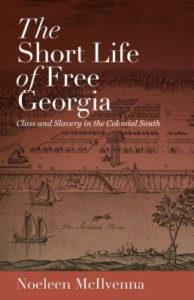 Did you know that, when Georgia was first established as a colony, there was no slavery allowed? This was quite a surprise to me when I first started working at Fort Frederica. In order to learn more about Georgia during its status as a free state, I read the book “The Short Life of Free Georgia” by Noeleen McIlvenna.
Did you know that, when Georgia was first established as a colony, there was no slavery allowed? This was quite a surprise to me when I first started working at Fort Frederica. In order to learn more about Georgia during its status as a free state, I read the book “The Short Life of Free Georgia” by Noeleen McIlvenna.
“The Short Life of Free Georgia” contains many interesting facts and ideas. James Oglethorpe, the founder of Georgia, did not like slavery. He didn’t oppose it on moral grounds (owning another person is wrong) but on economic grounds. Oglethorpe felt that slavery made white people lazy and unwilling to work. Because Georgia was a place to give the “worthy poor” a new start, slavery would not be allowed. The Trustees, who administered the Georgia Colony from its inception, agreed with Oglethorpe and set up the free colony.
Soon after the arrival of colonists on Georgia soil, however, the colonists started advocating for slavery. Their closest interactions were with the South Carolina planters. They could see the rich planters profiting from their slaves and their rice plantations. They felt they needed to follow this model in order to get rich in Georgia also. As long as Oglethorpe and the Trustees remained in charge, slavery was not allowed. But the Trustee’s charter expired after 20 years and slaves soon outnumbered white colonists. In fact, South Carolina planters became the majority landowners in the colony of Georgia.

In “The Short Life of Free Georgia” Noeleen McIlvenna writes an excellently researched book about this time. The young colony of Georgia could choose between several economic models. Oglethorpe promoted the “Pennsylvania” model: towns with small family farms surrounding them and a large middle class. Many of the early colonists, especially those with ambition, preferred the “South Carolina” model: a small, rich, aristocracy that lived off the labor of a large number of poor white people and slaves. In order to keep the majority of white people subservient, the South Carolina model required the rise of racism. White people were better than slaves based solely on the color of their skin, even if they were in similar economic situations.
This is an interesting hypothesis about the growth of slavery and racism in Georgia. The colonists believed the Pennsylvania model wouldn’t work in Georgia because the soil was so poor. But the Austrian Salzburgers who were original colonists in Georgia, were making their farms and towns work without slavery. I wonder what the history of slavery in the United States would have been like if Georgia had remained a free colony and become a free state in the south. Might we have abolished slavery much earlier, following the lead of Great Britain which abolished slavery in 1833.
“The Short Life of Free Georgia” is a short book, only 158 pages, full of big ideas. I finished it in January, but have thought of it frequently since then and discussed the ideas in it with others. For a country of free people, it is amazing how quickly we are willing to enslave or oppress others if it means we can get ahead financially. Instead of the land of the free, we might be the home of the greedy.
